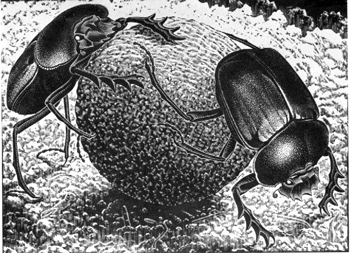scarab
(Greek: karabos, "crab, beetle"; Latin: scarabaeus, "beetle"; beetles)
2. Something foul or abhorrent.
3. To fertilize (land) with manure.
4. A reference to the defecation of animals.
All dung beetles are scarabs, but not all scarabs are dung beetles; for example, the protea beetle (Trichostetha fascicularis) gathers nectar from various species of proteas.
Protea consist of a tropical African shrub of the genus Protea having alternate rigid leaves and dense colorful flower heads resembling cones. Also described as an evergreen bush or tree, grown for its colorful bracts and dense flower heads. Native to southern Africa.
There are thousands of species of dung beetles, occurring worldwide wherever dung is found. Adults range from two to over fifty mm in length. Most species are dark colored, but a few have bright patterns or even metallic colors. Many species have distinctive horns or other distinctive characteristics.
There are many herbivores that eat a lot of grass in various geographical areas of the world. These herbivores produce a lot of dung, or droppings. What happens to the dung? Very special insects called scarab beetles, or dung beetles, break up the dung piles and move it away.

Once dung beetles find dung, they either begin to eat it, or they start rolling balls of it away. The beetles stand on their front feet and push the ball of dung with their back feet. These dung balls are often bigger than the beetle.
If these beetles did not exist, the pats of dung would harden and cover the ground. Grass and other plants would not be able to grow.
Some species of dung beetles prefer specific habitats (grassland or forest) or certain soil types (sand or clay). Some species feed on dung of only one species of animal, while others are not so limited. Most eat dung, but some scavenge carcasses or feed in decaying vegetation or fungi. Both adults and larvae feed on the food sources. Some species shape a brood ball which they roll away to bury, while others simply dig burrows under or near the feces and pack the dung into them.
2. A representation of this beetle, such as a ceramic or stone sculpture or a cut gem, used in ancient Egypt as a talisman and a symbol of the soul.

The Ancient Egyptians considered the scarab beetles as being sacred and
were revered as a symbol of the resurrection and the enduring human soul.
The dung beetle came to represent the Egyptian morning sun god, Khepri, and
the the Egyptians believed that scarab beetles rolled the sun across the
sky the same way they do a ball of dung across the sands.
They also thought that the beetles were symbols of rebirth, because of the way the parent beetle would bury itself underground and the newly hatched adults would emerge.
The Ancient Egyptians carved stones into the shape of scarab beetles as good luck charms. Although most people no longer believe they are sacred, scarab beetles are very important to the ecosystems of many parts of world.
2. They are known as "tumblebugs" in the U.S.
![]() Survival of dung beetles is vital to successful agriculture.
Survival of dung beetles is vital to successful agriculture.
![]() Contributions of dung beetles to healthier grazing animals.
Contributions of dung beetles to healthier grazing animals.
![]() Other "dung, feces, scarab, excrement" units:
copro-,
feco-,
scato-,
sterco-.
Other "dung, feces, scarab, excrement" units:
copro-,
feco-,
scato-,
sterco-.
A cross reference of other word family units that are related directly, or indirectly, with: "insects, bugs, worms; invertebrates": aphidi-; api-; ascari-; culci-; Dung Beetle Survival; Dung Beetles Important; Eating Worms; entomo-; formic-; Guinea worms; helmintho-; insecto-; Insects: Importance; isopter-; larvi-; lepidopter-; meliss-; mosquito; Mosquito, other Languages; Mosquitoes, Pt. 1; Mosquitoes, Pt. 2; myrmeco-; scoleco-; sphec-; taeni-; termit-; vermo-.
